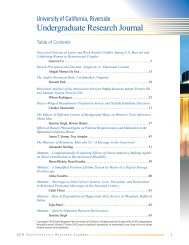2010 - Undergraduate Research, Scholarship and Creative Activity
2010 - Undergraduate Research, Scholarship and Creative Activity
2010 - Undergraduate Research, Scholarship and Creative Activity
Create successful ePaper yourself
Turn your PDF publications into a flip-book with our unique Google optimized e-Paper software.
Bacterial strain surface charge was only slightly<br />
affected by ionic strength, <strong>and</strong> low pH<br />
conditions. Results more importantly helped to<br />
show that PLGA nanoparticle surface charge<br />
could be modulated to mimic bacterial surface<br />
charge to ultimately increase uptake by M-cells.<br />
Studying the electrostatic properties of<br />
nanoparticles can give a better underst<strong>and</strong>ing of<br />
functionality of M-cells to ultimately aid in<br />
designing efficient <strong>and</strong> effective mucosal<br />
vaccine vehicles.<br />
Fluctuation Induced Forces Between Foreign<br />
Objects in a Biological Membrane<br />
Nancy Bernal-Flores, Physics<br />
Co-authors: Eugina Olivas, Chemistry/ Physics<br />
Hector Garcia, Physics<br />
Kriti Dube, Mathematics<br />
Dong Gui, Physics<br />
Hsiang Ku-Lin, Physics<br />
Contributors: Umar Mohideen, Leonid Pryadko<br />
Mentor: Roya Z<strong>and</strong>i<br />
Department of Physics <strong>and</strong> Astronomy<br />
The biological lipid bilayer membrane provides<br />
the stage for vital surface cellular processes,<br />
such as endocytosis <strong>and</strong> vesiculation. A number<br />
of recent simulations indicate the presence of<br />
attractive forces between inclusions embedded<br />
in a lipid membrane. The focus of these<br />
simulations has been on the forces associated<br />
with the elastic energies; in particular, on the<br />
forces mediated by the membrane curvature<br />
(Benidict J. Reynwar et al, 2007). The goal of<br />
our research is to show that the interaction<br />
between membrane inclusions is a consequence<br />
of the thermal fluctuations of the lipid<br />
membrane. We examine the trajectories <strong>and</strong><br />
interaction of glass <strong>and</strong> polystyrene microspheres<br />
over a free st<strong>and</strong>ing bilayer membrane<br />
using fluorescence-interferometry methods.<br />
These observations provide information for<br />
analysis of relevant physical factors such as<br />
membrane curvature, electrostatic <strong>and</strong> Casimir<br />
forces, Brownian motion, <strong>and</strong> thermal lipid<br />
bilayer perturbation interactions. Results suggest<br />
that fluctuation induced forces may lead to a<br />
microsphere bound-system formation <strong>and</strong> microsphere<br />
aggregation. Future experiments are<br />
under development to test interactions between<br />
foreign objects such as viruses <strong>and</strong> various kinds<br />
of proteins embedded in the surface of lipid<br />
membranes.<br />
The Evolutionary Breakdown of Symbiotic<br />
Cooperation between strains of<br />
Bradyrhizobium japonicum <strong>and</strong> their plant<br />
hosts<br />
Kameron Black, Neuroscience<br />
Mentor: Joel Sachs<br />
Department of Biology<br />
Symbiotic relationships among plants <strong>and</strong> many<br />
other living organisms serve as necessary roles<br />
in human life. Many of them benefit us in<br />
digesting foods <strong>and</strong> processing key nutrients,<br />
while others aid in the success of major cash<br />
crops. Yet a significant amount of these<br />
beneficial ties have been found to transform into<br />
uncooperative <strong>and</strong> even pathogenic bacterial<br />
strains. These evolutionary transitions can have<br />
devastating effects on symbiont-dependent<br />
activities. Such affects can include harmful crop<br />
yield reductions <strong>and</strong> emergent human<br />
pathogenesis. The evolutionary origins <strong>and</strong><br />
genetic causes of these harmful transitions have<br />
not yet been discovered <strong>and</strong> therefore my work<br />
will involve investigating questions such as:<br />
―With what frequency do these transitions occur<br />
in nature?‖, ―Are there specific parts of the<br />
bacterial ‗evolutionary tree‘ in which strains lose<br />
their symbiotic ability?‖, <strong>and</strong> ―What conditions<br />
allow for these transitions to occur?‖ The<br />
methods for investigating these questions<br />
involve attaining a sufficient model for the<br />
observations. This has been found in the strain<br />
Bradyrhizobium japonicum <strong>and</strong> its interaction<br />
with a bean plant host, Lotus Strigosus. Upon<br />
acquisition of a number of wild strains of the<br />
bacteria, the genomes of the strains will be<br />
sequenced through methods of archiving,<br />
extraction <strong>and</strong> replication of the DNA. After the<br />
data has been collected, analysis of the<br />
information should correlate with certain<br />
expected outcomes such as a degradation or loss<br />
of the bacterial symbiosis loci. In addition, an in<br />
vitro analysis of the bacterial response to living<br />
conditions absent from a plant host will be<br />
carried out. The targeted outcome of these tests<br />
is to observe whether the bacterial symbiosis<br />
Fourth Annual UCR Symposium for <strong>Undergraduate</strong> <strong>Research</strong>, <strong>Scholarship</strong> <strong>and</strong> <strong>Creative</strong> <strong>Activity</strong><br />
22














